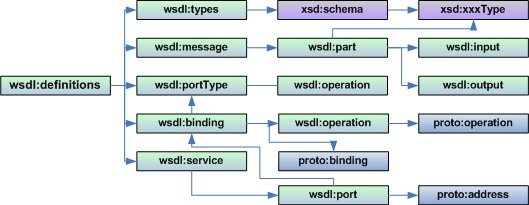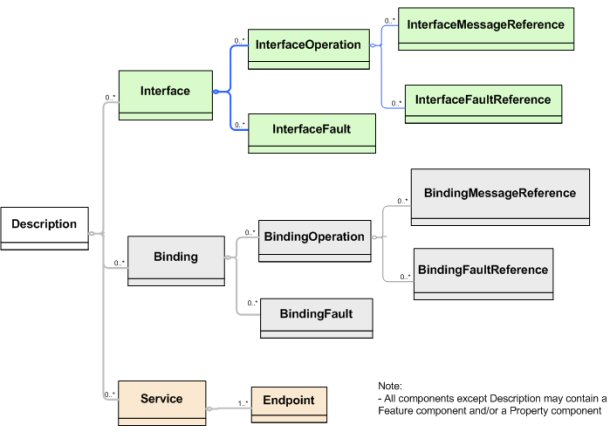Examples of WSDL - Web Service Description Language

WSDL (Web Service Description Language) for Web Services is the equivalent of IDL (Interface Definition Language) for distributed programming (CORBA, DCOM).
This language can accurately describe Web Services, including details such as
protocols, servers, ports used, the operations that can be performed, the
formats of the input and output messages, and exceptions that can be returned.
There were other attempts to solve the language problem of the definition of Web
Services.

By Ben Franske (Own work) [GFDL or CC-BY-SA-3.0-2.5-2.0-1.0],
via Wikimedia Commons
Firstly Microsoft proposed SDL (Service Definition Language) with an
implementation provided in their SOAP Toolkit and IBM proposed NASSL (Network
Accessible Service Specification Language), which an implementation is provided
in SOAP4J. Microsoft changed its initial specification and proposed SCL (SOAP
Contract Language) and the stakeholders agreed on WSDL. WSDL is seen as an
interface that is the entry point of any Web Service: There is the location of
the service, and operations that can be invoked using SOAP.
Structure of a WSDL Document
A WSDL document contains one or more definitions of Web services incorporating
the various components (data types, messages, port types, bindings and ports).
It is also possible to use the tag <Import> to break and gather WSDL documents.
As for SOAP, WSDL definition mentions Namespaces of reference where we find the
XML Schema definitions of WSDL tags themselves. The general skeleton of a WSDL
document is shown in the following diagram:

<definitions>
<message>
...
</ message>
<portType>
<operation> ... </ operation>
<operation> ... </ operation>
...
</ portType>
<binding>
...
</ binding>
<service>
<port> ... </ port>
<port> ... </ port>
</ service>
</ definitions>
A set of tags are used to define a service, and these parameters (input and
output). <definitions>: This is the root of all WSDL documents. This element
contains the service definition. This tag can contain attributes specifying the
service name, and Namespaces. It contains three types of elements:
- <message> and <portType>: These elements define the operations
offered by the service, their input and output parameters , etc.. In
particular, a <message> corresponds to an input or output parameter of a
<operation>. A <portType> defines a set of operations. An <operation>
defines a coupe input message / output message. For example, in Java, an
operation is a method and a portType is an interface.
- <binding>: This item combines a <portType> to a particular
protocol. Possible bindings are SOAP, CORBA or DCOM. Currently only SOAP is
used. It is possible to define a binding for each protocol supported.
- <service>: This element specifies the additional information
needed to invoke the service, and in particular the URI of the recipient. A
<service> is modeled as a collection of ports, a <port> is the combination
of a <binding> to an URI. Each WSDL element can be documented using the
<documentation> element. This element contains information related to the
understanding of the document by human users of the service. It is also
possible to define complex data types in a <types> tag just before the
<message> tag.
WSDL Example:
The following is a description of the Echo1 service defined by the following
Java class:

Public class Echo1 {
public String echo1 (String message) {
return "Message received:" + message;
}
}
<definition
2. xmlns: xsd = "//www.w3.org/1999/XMLSchema"
3. xmlns: soap = "//schemas.xmlsoap.org/wsdl/soap/">
4.
5. <message name = "echo1Input">
6. <part name = "expression" type ="xsd:string"/>
7. </ message>
8.
9. <message name = "echo1Output">
10. <part name = "expression" type = "xsd:string"/>
11. </ message>
12.
13. <portType name= "Echo1PortType">
14. <operation name = "echo1">
15. <input message = "echo1Input"/>
16. <output message = "echo1Output"/>
17. </ operation>
18. </ portType>
19.
20. <binding name= "Echo1SoapBinding" type ="tns:Echo1PortType">
21. <soap: binding style = "document"
22. transport = "//schemas.xmlsoap.org/soap/http" />
23. <operation name = "echo1">
24. <soap:operation soapAction = "urn:ServiceEcho1"/>
25. <input>
26. <soap: body use = "encoded"
27. encodingStyle =
28. "//schemas.xmlsoap.org/soap/encoding/" />
29. </ input>
30. <output>
31. <soap: body use = "encoded"
32. encodingStyle =
33. "//schemas.xmlsoap.org/soap/encoding/" />
34. </ output>
35. </ operation>
36. </ binding>
37.
38. <service name = "Echo1Service">
39. <port name = "Echo1Soap" binding = "tns:Echo1SoapBinding">
40. <soap: address
41. location = "//www.improve.fr/ServiceEcho1" />
42. </ port>
43. </ service> </ definition>
Explanation:
(5-11) The first part of the file defines the input and output parameters of
service operations: echo1Input and echo1Output.
(13-18)The abstract definition of the Web service is made by the portType
definition that encapsulates the definition of echo operation. This refers to
messages previously defined (input and output parameters of the operation). We
obtain an abstract service description, independent of any communication
protocol. This is the service interface that defines the methods exported, and
their input and output parameters.
(20-36) It is possible to combine this service with an existing protocol, by
the definition of a binding (for example, we are interested in: SOAP). The
binding defines the invocation parameters of specific service operating to the
used protocol. Here we define the parameters required to use the service through
SOAP (link to the specifications of transport used, encoding rules for
serialization of exchanged messages, etc..).
(38-43) The service definition ends with the definition of the remaining
parameters. For example, for a SOAP binding, it remains to define the URL
address of the service to invoke. Note that it is possible to define multiple
bindings, and to associate these bindings to multiple URLs by using the same
abstract service definition.
WSDL Creation Tips
For a maximum of interoperability while maintaining flexibility, here are some
tips to create a WSDL document:
- Always Document your WSDL file, both through the documentation tag, and
by providing documentation in an external file to the WSDL document.
- Use the XML Schema Recommendation 2001. You can put many things in the
item types of a WSDL document: Relax NG, an old version of XML Schema or
anything else, but the safest and interoperable method is the 2001 version
of Schema.
- Use the element types :Even if the messages have a simple data type, you
must still use the types element to describe everything. In any case, do not
refer to types in the element message.
- Divide your WSDL document into several pieces by leveraging the import
function: create a file for the abstract aspect of WSDL, one for links and
one for the service features and ports.
- Start designing your service by WSDL, and keep the interface unchanged
from end to end, even if the WSDL is generated by the tools. This means that
you will often compare your code to WSDL.
Programming
Introduction to Java EE (Part 1)
How the Google App Engine Works
WSDL - Web Service Description Language
SOAP: Simple Object Access Protocol
Initiation to Cryptography and Encryption to Secure Data
Introduction to Design Patterns in Java
How To Write Efficient Programs in Java
Proper Management of Logs in .Net
How To Remove FaceBook Action Ids From URL |